.jpg )
‘HARRY HJ’ had a tough life before Al picked it up and he knew it would need some rebuilding, but the longer (800mm) wheelbase provided ideal dimensions for slide-on camper fitment, so the refurb began.
Paint, body mounts, sound deadening, Long Ranger 160-litre rear tank, seats, front and rear bars, diffs, half shafts, wheel ends, brakes, propshaft, main box and transfer case rebuild, Bilsteins/Polyairs/Kings springs and engineering approval for 3.5 tonnes GVM were all fitted and sorted.
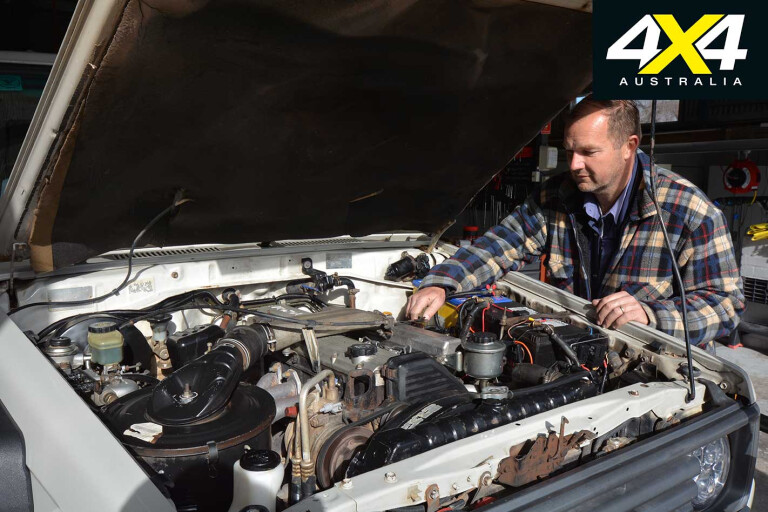
As a bush beast the HJ has proved to be almost invincible, but on-highway performance from the naturally aspirated 1HZ was less than brilliant. In its past life someone had fitted extractors, in the hope that better exhaust breathing was necessary.
With a fully loaded Tray-Tek camper and topped-up fuel and water tanks, Harry uses up all of his GVM upgrade. With the boat trailer behind as well, its performance on highway grades was… modest. Al and his better half, Kez, were running the risk of being shunted up the bum by loaded B-doubles.
Al took the Cruiser to the experts at Berrima Diesel, for power and torque improvements. Andrew Leimroth checked out the 1HZ and pronounced it fit for mild turboing. Al has always been wary of fitting turbochargers to engines that weren’t designed for them, but Berrima Diesel has been doing this job for many years, with great success, provided people don’t ‘fiddle’ with their dyno-proved fuel and boost settings afterwards.

Also, we were reassured by the fact that Toyota did produce a factory turbo version of the 1HZ – the 1HZ-T – that was fitted to Coaster buses in Europe, before the advent of the direct-injection 1HD-T. If the worst happened – piston, rod or bearing failure – there were plenty of upgraded bits available, Al reasoned.
The job started with a third-gear dyno test that revealed a very modest rear wheel power figure of 59.8kW. Off came the standard inlet plumbing and extractors, and in went the DTS turbo kit’s inlet plumbing and exhaust manifold. Because the extractors had replaced the standard exhaust system, a length of exhaust pipe with flange had to be made up to mate to the turbo-kit’s exhaust manifold. Then on went the Mitsubishi turbo.
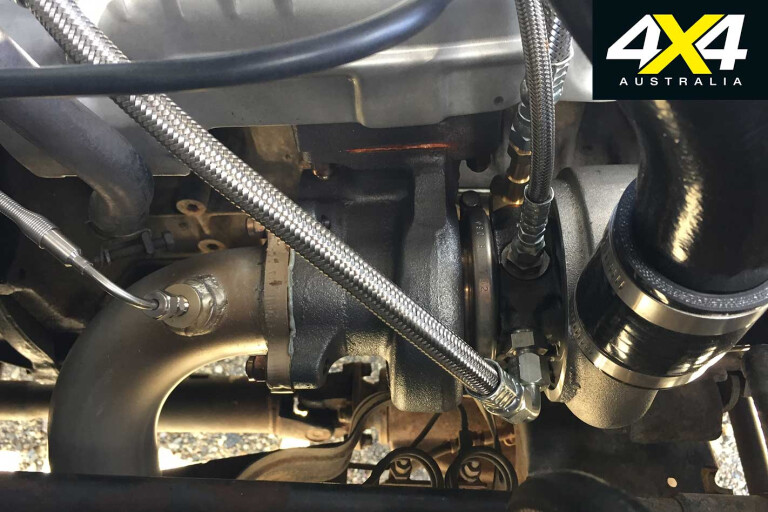
Oil lines and water pipes were connected and a Redarc exhaust gas temperature probe was fitted to the exhaust pipe. The gauge fit neatly beside the Land Cruiser instrument binnacle, providing a clear readout of boost pressure and exhaust temperature.
Back on the dyno there was an immediate improvement in output, even with the standard fuel pump settings. Rear wheel power went up to 63.1kW. After pump adjustments, the final figure was 75.6kW – a 25 per cent increase.
Third-gear calculated torque was originally 374.5Nm, and it went up to 425.6Nm before fuel pump adjustment, finishing at 502.2Nm – an increase of around 130Nm, or 30 per cent.
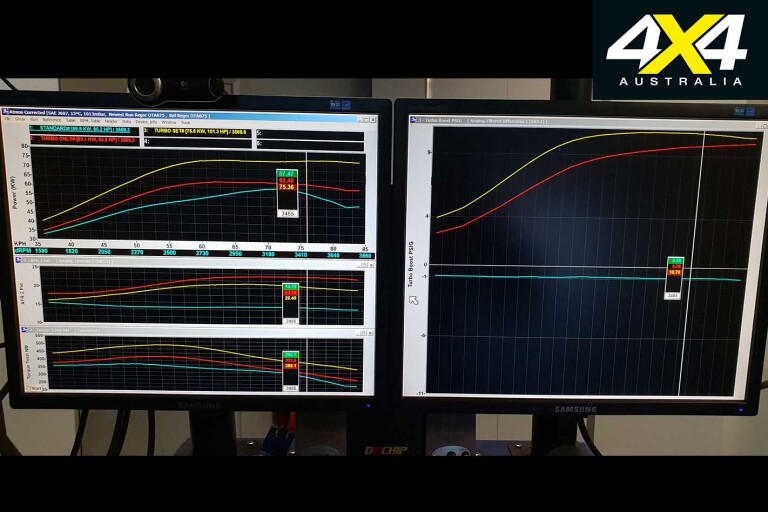
In its original form the 1HZ engine operated under load with an almost exact stoichiometric air/fuel ratio of 14.7:1 (the weight of air required to burn the corresponding weight of fuel injected). A stoichiometric ratio is critical for safe and efficient combustion in petrol engines, but diesels are happy to operate at lean mixtures and suffer no penalty from excess air, unlike petrol engines that can run hot when leaned off.
The advantage of a lean diesel mixture is less smoke, thanks to better combustion at full load and when accelerating. With its new turbo spinning, the Cruiser ran an air/fuel ratio mostly in the 18:1 to 21:1 range.
On the road the difference was stark. Harry was a gear better on Al’s test hills and made no smoke at all, even under harsh acceleration. Flexibility in all gears was improved and engine noise levels were much lower, thanks to a rotary ‘silencer’ that chopped up inlet tract noise.
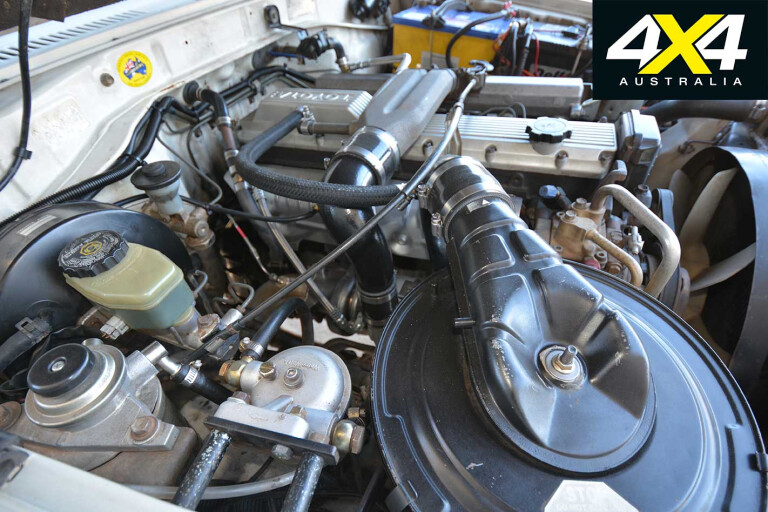
The Cruiser was tested under load by pulling a car trailer with a mate’s ancient Land Rover on its back. Very satisfying, that! Towed weight was exactly 2.5 tonnes. On the flat Harry was unfazed by the trailing weight, so Al pointed him up the 10 per cent grade from NSW’s Kangaroo Valley to Moss Vale: a 25-kilometre slog on tight, winding bitumen.
His eyes were glued to the Redarc pyro throughout this climb, which Harry managed mostly in second cog, with a feathered accelerator pedal and revs around 2000rpm. The gauge registered maximum boost of only six psi, the exhaust temperature ran in the 250-350°C range and the coolant gauge needle didn’t move for the entire climb. Not much combustion stress there, he reckoned.
Al tried third gear at times, but the pedal went to the floor, revs fell back, road speed didn’t increase and boost and exhaust gas temperature started to rise, so he reverted to second. Before the turbo fitment Harry would have held second on the straighter bits, but he’d certainly need to drop into first for tight corners.
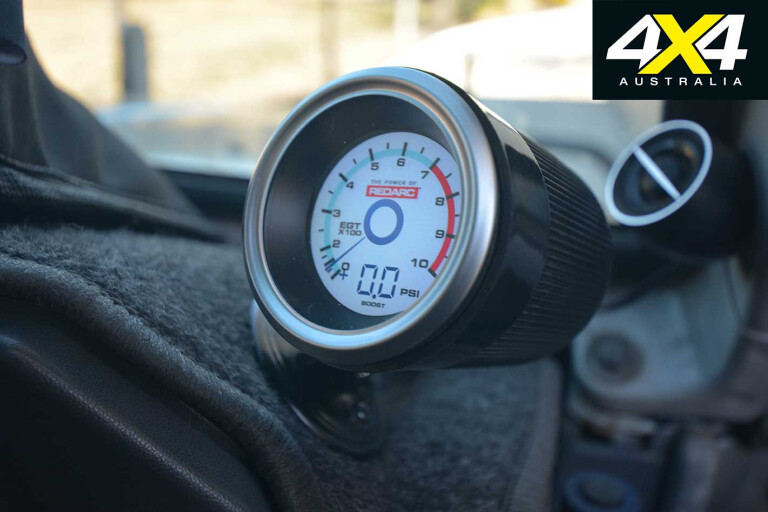
On-highway driving, with Harry only lightly loaded, was done mainly in fifth gear and hills that previously saw him back to fourth at 80km/h are now conquered in fifth at 105km/h. Boost never exceeded 10psi and exhaust temperature was typically 300-350°C, with one instance of 400°C for a few seconds. The coolant gauge needle didn’t move off its normal position.
The next test trip was done with the Whitings’ Tray-Tek camper on the back and a 300kg Hobie trimaran and boat trailer bobbing along behind. Flexibility was greatly improved and a two-day highway driving stint was quite relaxed. All the freeway and highway hills were handled in fourth and fifth, where before Harry needed third and even second on quite a few climbs.
It’s still early days for assessing overall fuel economy, but first impressions are a slight improvement over previous 12-15L/100km figures, despite greatly improved performance.
The four-grand investment certainly seems to be paying off.

COMMENTS